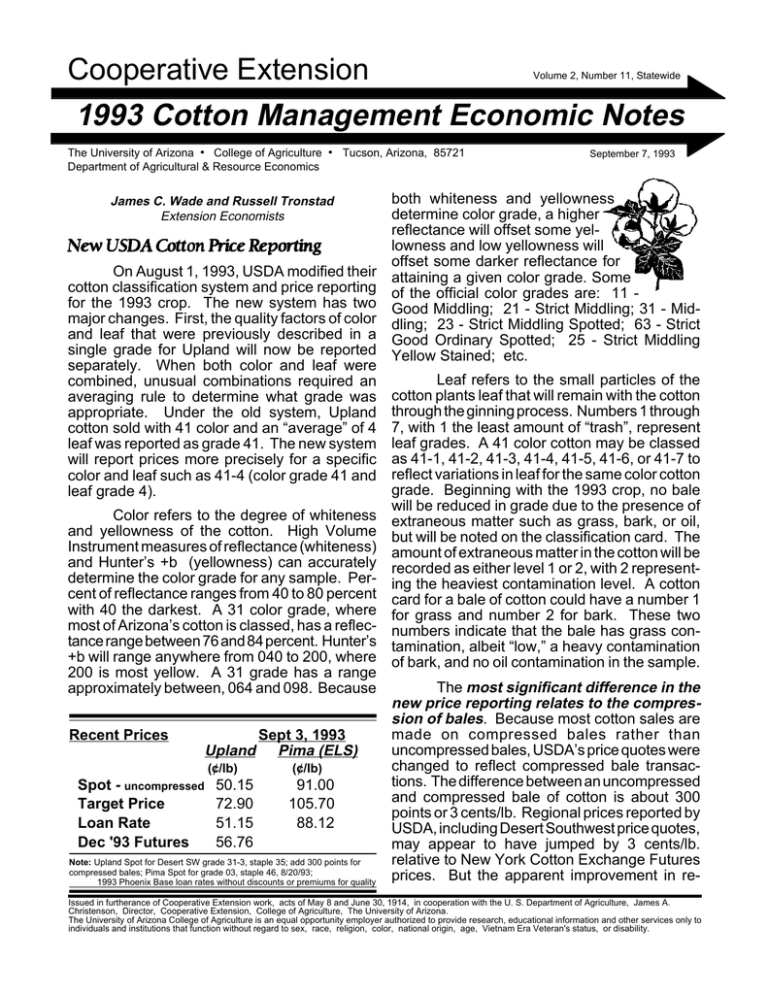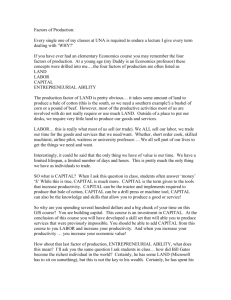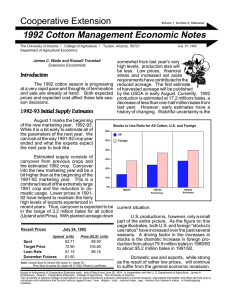Cooperative Extension 1993 Cotton Management Economic Notes •
advertisement

Cooperative Extension Volume 2, Number 11, Statewide 1993 Cotton Management Economic Notes The University of Arizona • College of Agriculture • Tucson, Arizona, 85721 Department of Agricultural & Resource Economics James C. Wade and Russell Tronstad Extension Economists New USDA Cotton Price Reporting On August 1, 1993, USDA modified their cotton classification system and price reporting for the 1993 crop. The new system has two major changes. First, the quality factors of color and leaf that were previously described in a single grade for Upland will now be reported separately. When both color and leaf were combined, unusual combinations required an averaging rule to determine what grade was appropriate. Under the old system, Upland cotton sold with 41 color and an “average” of 4 leaf was reported as grade 41. The new system will report prices more precisely for a specific color and leaf such as 41-4 (color grade 41 and leaf grade 4). Color refers to the degree of whiteness and yellowness of the cotton. High Volume Instrument measures of reflectance (whiteness) and Hunter’s +b (yellowness) can accurately determine the color grade for any sample. Percent of reflectance ranges from 40 to 80 percent with 40 the darkest. A 31 color grade, where most of Arizona’s cotton is classed, has a reflectance range between 76 and 84 percent. Hunter’s +b will range anywhere from 040 to 200, where 200 is most yellow. A 31 grade has a range approximately between, 064 and 098. Because Recent Prices Upland (¢/lb) Spot - uncompressed Target Price Loan Rate Dec '93 Futures 50.15 72.90 51.15 56.76 Sept 3, 1993 Pima (ELS) (¢/lb) 91.00 105.70 88.12 Note: Upland Spot for Desert SW grade 31-3, staple 35; add 300 points for compressed bales; Pima Spot for grade 03, staple 46, 8/20/93; 1993 Phoenix Base loan rates without discounts or premiums for quality September 7, 1993 both whiteness and yellowness determine color grade, a higher reflectance will offset some yellowness and low yellowness will offset some darker reflectance for attaining a given color grade. Some of the official color grades are: 11 Good Middling; 21 - Strict Middling; 31 - Middling; 23 - Strict Middling Spotted; 63 - Strict Good Ordinary Spotted; 25 - Strict Middling Yellow Stained; etc. Leaf refers to the small particles of the cotton plants leaf that will remain with the cotton through the ginning process. Numbers 1 through 7, with 1 the least amount of “trash”, represent leaf grades. A 41 color cotton may be classed as 41-1, 41-2, 41-3, 41-4, 41-5, 41-6, or 41-7 to reflect variations in leaf for the same color cotton grade. Beginning with the 1993 crop, no bale will be reduced in grade due to the presence of extraneous matter such as grass, bark, or oil, but will be noted on the classification card. The amount of extraneous matter in the cotton will be recorded as either level 1 or 2, with 2 representing the heaviest contamination level. A cotton card for a bale of cotton could have a number 1 for grass and number 2 for bark. These two numbers indicate that the bale has grass contamination, albeit “low,” a heavy contamination of bark, and no oil contamination in the sample. The most significant difference in the new price reporting relates to the compression of bales. Because most cotton sales are made on compressed bales rather than uncompressed bales, USDA’s price quotes were changed to reflect compressed bale transactions. The difference between an uncompressed and compressed bale of cotton is about 300 points or 3 cents/lb. Regional prices reported by USDA, including Desert Southwest price quotes, may appear to have jumped by 3 cents/lb. relative to New York Cotton Exchange Futures prices. But the apparent improvement in re- Issued in furtherance of Cooperative Extension work, acts of May 8 and June 30, 1914, in cooperation with the U. S. Department of Agriculture, James A. Christenson, Director, Cooperative Extension, College of Agriculture, The University of Arizona. The University of Arizona College of Agriculture is an equal opportunity employer authorized to provide research, educational information and other services only to individuals and institutions that function without regard to sex, race, religion, color, national origin, age, Vietnam Era Veteran's status, or disability. Estimated To-Date Production Costs $/lint lb (August 30) The following table gives estimated production costs/lb to-date. These costs include both growing and fixed or ownership costs and are based on the displayed target yields. Producers with higher yields will have lower costs/lb if input costs are the same. Growers with lower yields will have higher costs/lb. County Target Yield Yuma 1,300 1,300 1,100 1,250 1,300 1,100 700 1,050 850 La Paz Mohave Maricopa Pinal Pima Cochise Graham Greenlee Growing Costs August To Date .13 .05 .06 .08 .06 .08 .05 .04 .03 . 29 .24 .25 .23 .28 .26 .51 .28 .32 Fixed All Costs Cost To Date .25 .27 .23 .23 .26 .28 .42 .31 .36 .54 .51 .48 .46 .54 .54 .93 .59 .68 Note: Based on Wade, et al., “1992-93 Arizona Field Crop Budgets”, Various Counties, Arizona Cooperative Extension, Tucson, January 1992. gional price differences is primarily reflecting a change in USDA regional cotton price quotes from uncompressed to compressed bales. The differential between “farm prices” and futures prices are basically the same as prior to August 1, 1993. gets are estimated on a more local basis using local pricing of inputs and standard local practices. But a caution is in order for these estimates as well. Budgets are estimates of cost of production before the crop is produced using expected prices and practices. Farm and current season conditions may vary greatly from those used to estimate the Budgets. Published Budgets are, therefore, best considered planning "cost of production" estimates. Individual farm estimated and actual cost of production vary according to location and seasonal conditions. Never-the-less Budgeted cost of production estimates are valuable planning tools that are becoming more frequently used by lenders, insurers and farmers to examine the potential for farm profits. Managing Costs. The real cost of production is of course, what actually is happening in the fields this year. Many important factors contribute to the actual costs; insect populations, water costs and rainfall, and weed infestations are key components. The key questions are: How can growers manage costs? What can they control? How can they exercise their control? Cost control is not easy. Growers rightfully are concerned about managing a crop to make good yields and good quality. They tend The average or representative cost of to only look at costs after the year is over. producing cotton is a very difficult thing to estiIncreased control is a matter of improved mate with any degree of accuracy. The table information about crop conditions and pest probabove has been updated throughout the season to reflect the representative cost for each county lems. While information is not free, it may cost in Arizona. However, these estimates are for an a lot less than the inputs used in the absence of assumed set of growing conditions and for a information. Close monitoring of crop water likely yield. Each grower should estimate his conditions, insect populations and damage, crop cost of production each year both during and fertility and weed conditions provide growers the opportunity to forgo the use on some inputs. after the season. Defoliation and harvesting can prove to Planning Costs. Costs of production be very costly, both in actual dollars spent and are used in several ways by different people. in terms of quality reduction, if the use of fertilizer The USDA "monitors" cost of production to help and irrigation water inputs are not closely moniCongress and the USDA in setting government Farm Program payments and in establishing tored and adjusted to local conditions. Harvest export and import policies. They take grower equipment must also be properly serviced, adsurveys of costs for specific crop years and justed and monitored to avoid unnecessary loses estimate the costs. These data are normally of quantity and quality of yield. averaged across large areas such as states and It likely surprises few growers that monifor the US as a whole and are of little use for toring and control are required to control costs. grower planning. The critical question is do growers really see the In contrast, the estimates used in this value of added information or do they see this newsletter and in the Arizona Field Crop Bud- information as simply an added cost? Cost of Production: Assessing the Estimates Disclaimer: Neither the issuing individuals, originating unit, Arizona Cooperative Extension, nor the Arizona Board of Regents warrant or guarantee the use or results of this publication issued by the Arizona Cooperative Extension and its cooperating Departments and Offices.



